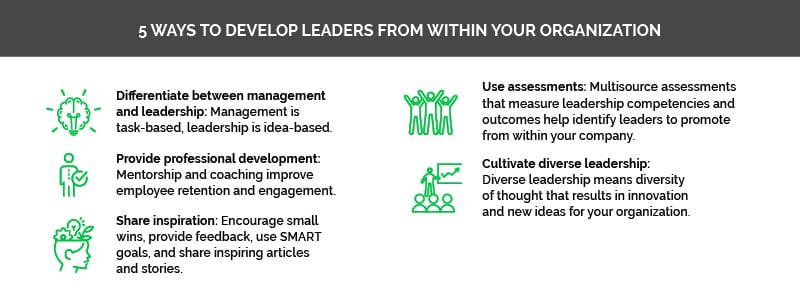5 Ways to Develop Leaders From Within Your Company

When scaling your business, you'll need a team of strong leaders at your side. Here's how to develop the leaders of tomorrow already on your team.

Leadership training and development within your organization are important for all employees. The best way to find the leaders of tomorrow is to create them today. While it may seem easier to hire from outside your organization than develop the talent within, promoting from within boosts employee morale, gives your best talent something to work towards, and allows you to have input in the leadership development process.
Providing in-house leadership development is beneficial for employee retention and engagement. This is especially important in light of the success rates of most leaders. Studies have found that in the first 18 months of attaining a leadership role, 30% to 70% of leaders fail. This is quite costly in terms of time and resources. It’s estimated that it costs between $750,000 to over $2.5 million to replace senior leaders. The higher the leadership position, the higher the costs associated with replacing them becomes — replacing a CEO can cost anywhere from $12 million to $52 million.
Inconsistent or failed leadership creates increased stress and decreased engagement for employees, and it impacts employee retention rates. Yet, if you’re going to scale your business, you need a strong team of leaders surrounding you. Here’s how to cultivate leaders from within your organization.
1. Know the difference between management and leadership
Traditionally, managers haven’t been taught to lead, but rather to manage, engaging in activities like budgeting, forecasting, planning, controlling, and delegating. Management is largely a task-based role. Most managers tend to be leaders, but not all.
Leadership has very little to do with delegating tasks and assigning work. Leadership is an ideas-based and relational role. Leaders influence and inspire. You may notice that you have leaders influencing and inspiring at your company already. They don’t necessarily have to occupy a managerial position to be effective. Leadership qualities can be found in anyone at any level and in any role.
Effective leaders care about people and take an interest in the success of those who look up to them. Leaders have the ability to challenge the status quo, inspire new ideas, and operate from a place of honesty and integrity.
Simply put, managers organize while leaders innovate. Managers control while leaders inspire trust. Leaders ask “what” and “why” while managers concern themselves with “how” and “when.”
2. Provide opportunities for professional development
Mentorship programs reduce training costs and support a company culture of learning. Mentorship also improves onboarding, productivity, workplace culture, employee engagement, and employee retention. In 2019, LinkedIn’s Workforce Learning Report noted that 94% of employees said they’d stay at a company longer if it invested in them by providing learning opportunities.
Mentorship and coaching programs have been shown to improve business growth. A survey of over 2,000 employees found that organizations that offer opportunities for professional development increase employee engagement by 15%. These businesses also see 34% high retention rates compared to businesses that don’t offer professional development opportunities.
Providing professional development opportunities isn’t just an investment in your employees, it’s an investment back into your business.
3. Share inspiration
As a founder, you’re also a leader. Model the behavior you’d like to see displayed by your organization’s leadership team. Inspired people spark innovation and ideas. Share inspiring articles, quotes, and videos as appropriate to help create that environment.
The “progress principle,” studied by the Harvard Business Review, has found that progress at work impacts not only an employee’s overall mood, but with it, their motivation to make progress. Even small, incremental successes were shown to be powerful enough to create positive momentum. Use realistic goal-setting methods so your team is able to reasonably meet objectives. Celebrate your team’s small wins and provide encouragement and appropriate feedback. View failure as opportunities for growth and teach your team to have a growth mindset.
4. Use leadership assessments
Using assessments to forecast leadership performance can save organizations time and money. Studies of large, multinational organizations, most of which ranked in Fortune’s “Top Companies For Leaders,” revealed that high-performing companies used assessments for both leadership development and decision-making.
The studies found that the three most commonly used assessments are:
- One on one interviews
- 360-degree feedback systems
- Personality inventories
Leadership competencies and outcomes were the things most commonly assessed. The majority of these companies used a multi-pronged approach, leveraging multiple styles of assessments in order to mine as much data about their prospects as possible.
5. Cultivate diverse leadership
Research on diversity in leadership has noted a link between diversity and an organization’s overall success and performance. Nearly 2/3s of learning, development, and HR professionals surveyed in the 2021 LinkedIn Workplace Learning Report reported making diversity, inclusion, and equity a priority in the workplace.
Diversity is more than just an HR buzzword. Diverse leadership results in diversity of thought, which facilitates innovation and new ideas for your organization. Bear in mind that diversity goes beyond gender and race. Diversity can include religion, age, sexual orientation, disability status, educational experience, parent/caregiver status, socioeconomic status, and many other identifying factors.
Promoting from within has multiple benefits: increased employee morale resulting in increased productivity, improved employee retention, and the fact that internal hires are able to better adapt to their positions in leadership than external hires. Now that you know some of the benefits, who at your organization do you think might be a good candidate for leadership training?
MetaGrowth can help you build a sales team of leaders
At MetaGrowth, we help companies hire, train, and maintain sales teams that deliver maximum results and minimal risk for our clients, so you can ditch the daily grind of “founder selling” by having an amazing team of dedicated sales professionals to do your selling for you. Co-founders Josh Hirsch and Joe Arioto will put their combined 30,000 hours of coaching and consulting expertise to work for you on solutions-based sales consulting that frees up your time to focus on what really matters: Your growth strategy.
If you want to build your very own world-class sales team without investing a ton of time — not to mention headaches or hassles — contact us today. We’ll help you build a dream team to start boosting your sales in no time!
Written by
Joe Arioto
